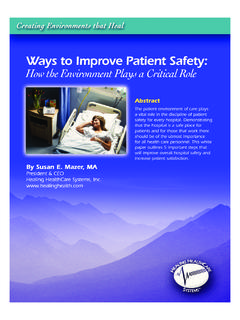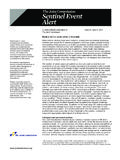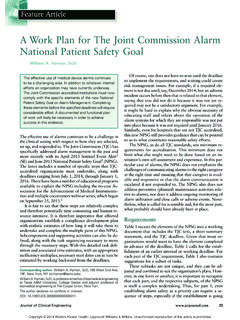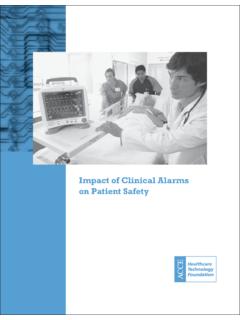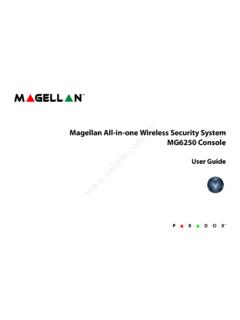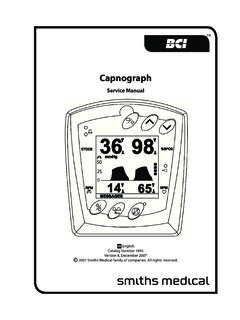Transcription of Creating a Culture of Safety Reducing Hospital Noise
1 350 Biomedical Instrumentation & Technology September/October 2012 Features Creating a Culture of SafetyReducing Hospital NoiseSusan E. Mazer, PhDEditor s Note: In 2006, Susan E. Mazer wrote an article for BI&T that examined the impact of Hospital Noise on patient Safety . Six years later, Mazer takes a fresh look at the issueIn comparing the state of healthcare in the 19th century with that of the 21st century, it is clear that the uncontrollable and seemingly unmanageable ways that Noise penetrates the Hospital environment has changed for the worse. Florence Nightingale, whose environ-mental theory became the original basis for professionalizing nursing care, described Noise as that which damages the patient. 1 At that time, the Noise to which Nightingale referred included squeaking floors, brushing crinolines, appropriate and inappropriate conversations any sound that resulted in feelings of apprehen-sion, uncertainty, waiting, expectation, fear or surprise.
2 2 Today, Hospital Noise has been studied according to its physiological and psychological outcomes: increased respiratory rates, heightened blood pressure, increased heart rates, and increased ,4 While some improvements have been made in acoustic treatment of corridors and rooms,5,6 they are not industry wide nor are they Hospital wide. Generally, the improvements have been made in one unit of a Hospital , clinical area, or clinic. Meanwhile, negative auditory factors have multiplied: growing populations, higher patient acuity levels, increased pressures on staff to perform, and the introduction of more new technologies have replaced older ones: Overhead paging has been traded in for mobile technologies, and the irritating broadcast of announcements has been replaced by the near-constant use (in corridors and rooms) of cellphones or other individual communication technologies.
3 Each new technology has its own environmental impact, requires its own utiliza-tion policy, and introduces new risks as well as benefits. The studies to date have merged the technological sounds into the generic auditory environment and the outcomes remain the same: Hospital Noise is pandemic. The auditory environment of the 21st century Hospital is substantially louder, more complex, and more difficult to control than that of Nightingale s time. Intensive care unit (ICU) psychosis or delirium has been directly linked to environmental stressors Noise , sleep deprivation, and social isolation, being The costs related to sleep deprivation, agitation, stress, and lower pain thresholds that are a result of ambient Hospital Noise are measured in additional medication, length of stay, and subsequent complications.
4 Defining the Patient ExperienceConsumer assessments of healthcare providers and systems (HCAHPS) scores have included the environment of care as a significant About the AuthorSusan E. Mazer, PhD, is the president and chief executive officer of Healing HealthCare Systems, a company based in Reno, NV, that produces The Channel and other products and services to help healthcare organizations create healing environments. E-mail: While some improvements have been made in acoustic treatment of corridors and rooms, they are not industry wide nor are they Hospital wide. Generally, the improvements have been made in one unit of a Hospital , clinical area, or clinic. Copyright AAMI 201. Single user license only. Copying, networking, and distribution Instrumentation & Technology September/October 2012 Featuresindicator as to what happens to patients.
5 Among the 27 questions in the HCAHPS survey, two deal with the environment from the patient The first focuses on the cleanliness of the patient s bathroom. The second and the one that has consistently been given the lowest score is: How often do you experience quiet around your room at night? This question has many implications, with Noise at night being the primary cause of sleep ,10 According to The American Heritage Diction-ary of the English Language, Fourth Edition, the noun sound is defined as vibrations trans-mitted through an elastic solid or a liquid or gas, with frequencies in the approximate range of 20 to 20,000 hertz, capable of being detected by human organs of hearing. 11 This definition, however, has little to do with the experience of a sound and its qualitative impact, which is relative to the capacity and circumstances of the listener.
6 The context in which Noise occurs and ultimately the meaning attributed to it becomes a contextual experience for the patient, one distinctly subjective which is informed by the character of the sound. The individual nature of this perception, however, contributes to its potential physiological is a plethora of articles and research available regarding Noise as a human and technological outcome and a consequence of living beyond the industrial and digital revolu-tions. Noise is an adverse auditory event; it is neither benign nor considered neutral. At the same time, the impact of Hospital Noise can vary and what is Noise to a patient may be critical information to a nurse about another patient (such as an alarm). The studies listed below have shown that the impact of Noise on patients, families, and staff is hardly positive.
7 2006 Mayo Clinic study found that Noise was the major cause of sleep HCAHPS scores Noise as the number one complaint, consistently receiving the lowest Hospital Noise slows healing during a , 14 Noise increases the perception of pain while heightening anxiety and Noisy environments contribute to communi-cation Noisy environments contribute to learned-helplessness. 15 Noise contributes to medical and nursing ,17 Medical Alarm FatigueThe AAMI Medical Device Alarms Summit in October 2011 focused on one aspect of Hospital Noise the challenge posed by the cacophony of medical alarms. In addition to the conse-quences of non-actionable alarms on the staff, the environmental impact spreads throughout the whole unit.
8 For the patient whose bedside monitor alarm triggers for any reason, sleep deprivation or agitation stunning statistic to consider comes from a Stanford University study that revealed that only of cardiac alarm conditions indicated critical events. Further, the number of cardiac monitor alarm events in a two-month period within six units and 154 beds, totaled 318,000 If we take these numbers as the average number of alarms per bed, we are looking at 2,065 alarms per bed over two months, with 2,000 of these being non-critical. The microenvironment of the patient, then, becomes his or her bed and the alarm. Understanding the RisksAmbient Noise is the primary cause of sleep deprivation and disturbance for patients, which The modern Hospital environment is full of Noise beeps and alarms from devices, paging systems, telephones, conversations, the movement of equipment, and more a fact that can often prove stressful for patients and staff alike.
9 Copyright AAMI 201. Single user license only. Copying, networking, and distribution Instrumentation & Technology September/October 2012 Features causes confusion and can result in increased medication and restraint ,20-23 It increases their anxiety and decreases their confidence in the clinical competence of the , Noise -induced stress is conta-gious, impacting family members who eventually wind up at the nurses station complaining about a variety of issues worsened by the extraneous Noise . Sudden noises, such as a dropped tray or slammed door, often cause a startle reflex in patients, resulting in physi-ological responses such as facial grimacing, muscular flexion, increased blood pressure, higher respiratory rate, increased heart rate and vaso-constric-tion24,25 Ventilated or semiconscious patients still hear sounds around them, and the startle reflex is especially risky for them due to their high acuity and severely impaired ability to adapt or respond.
10 As Nightingale said, the sick suffer in a greater proportion than the well from precisely the same causes. 1 Patients exposed to continuous extraneous Noise can also experience altered memory, increased agitation, less tolerance for pain, and feelings of These environmentally generated symptoms are often medicated or otherwise treated in ways unrelated to their Happens to StaffThose who work long shifts in noisy environ-ments, day in and day out, have experiences similar to patients. Nurses report exhaustion, burn-out, depression and irritability. In addition, interfering and distracting sounds have been shown to contribute to medical and nursing The Joint Commission (TJC) also mentions Noise as a potential risk factor related to medical and nursing errors, stating that the ambient sound environments should not exceed the level that would prohibit clinicians from clearly understanding each The exact sound pressure level or volume that would be appropriate is not absolute.
